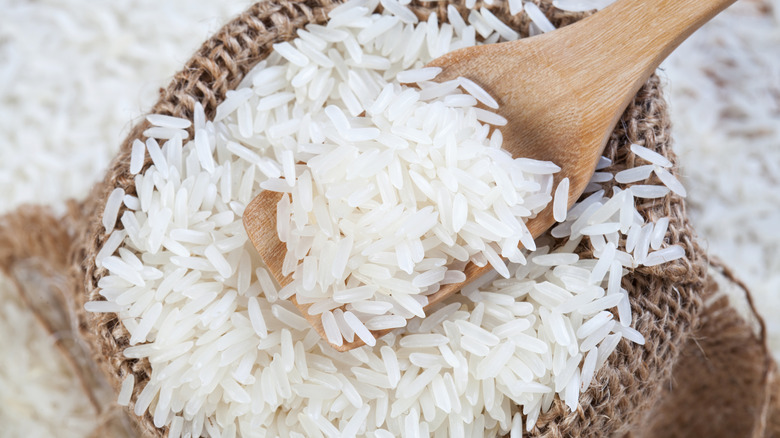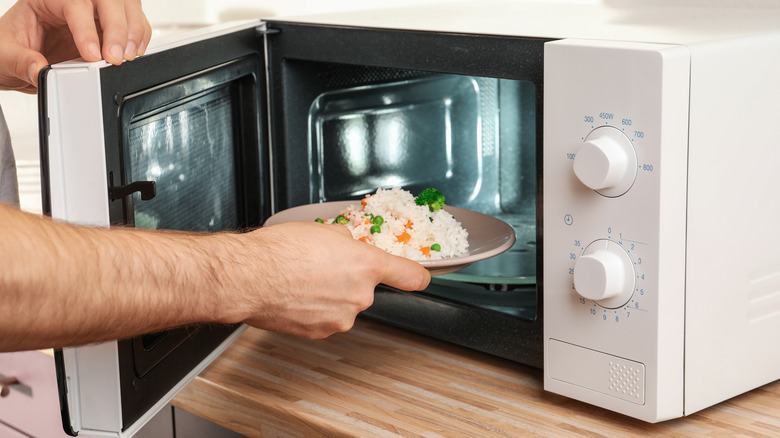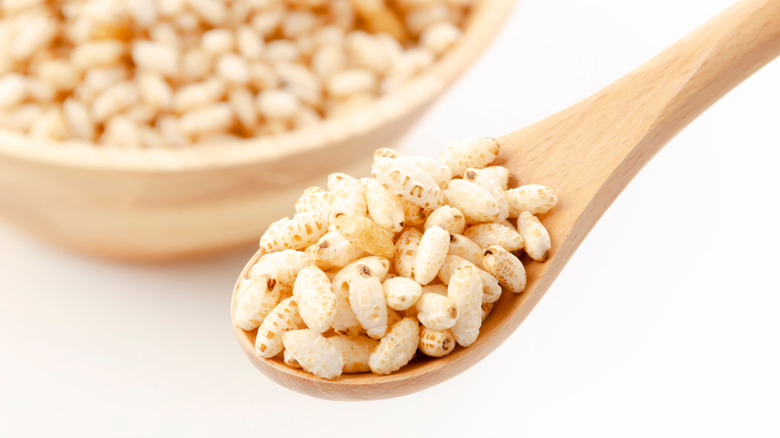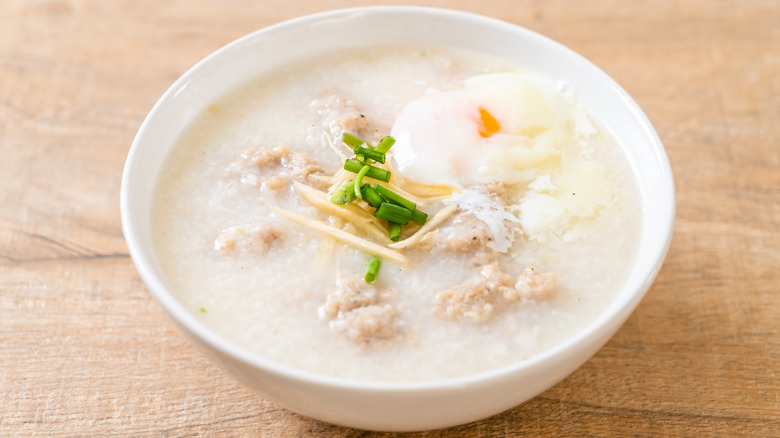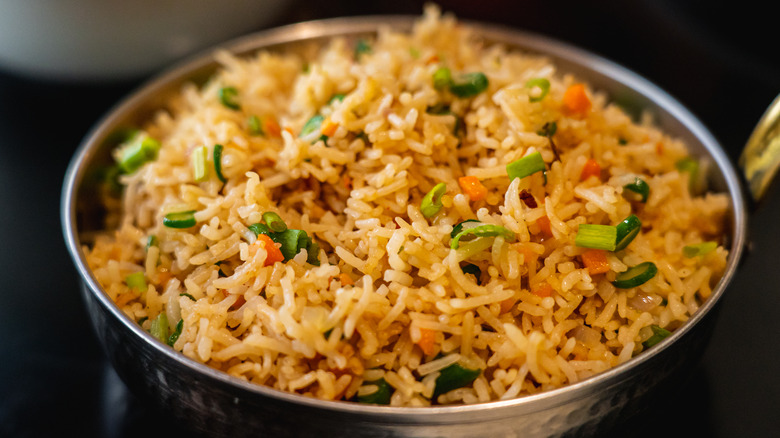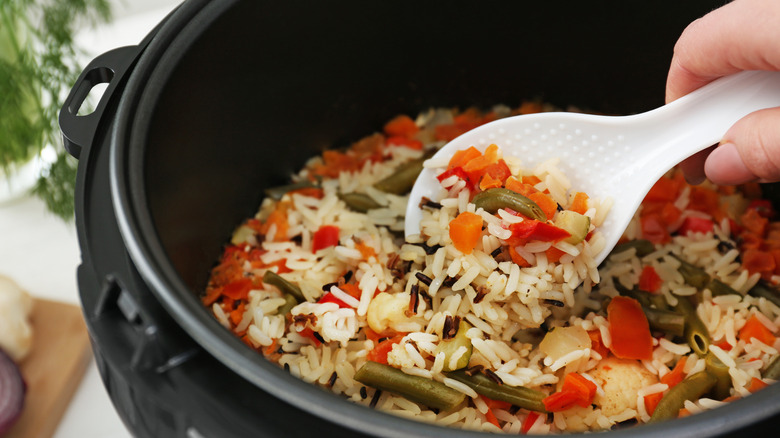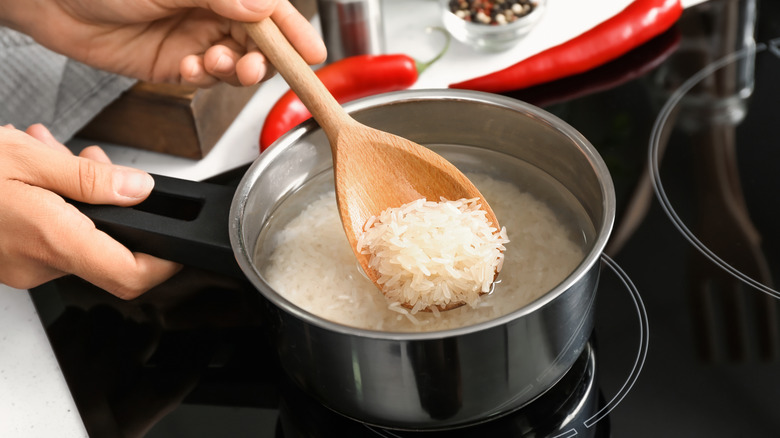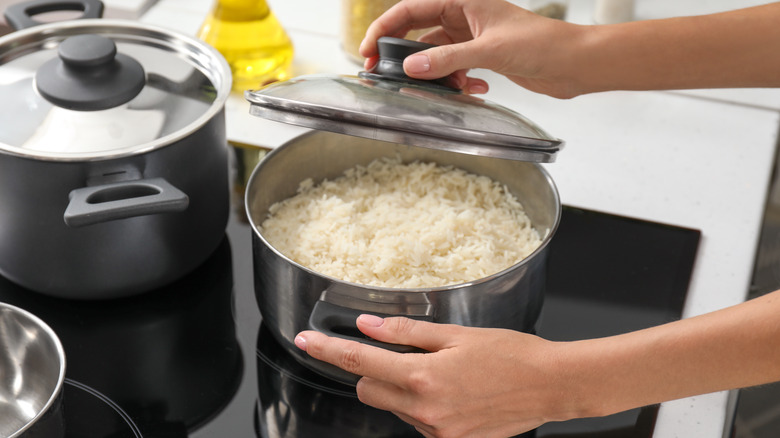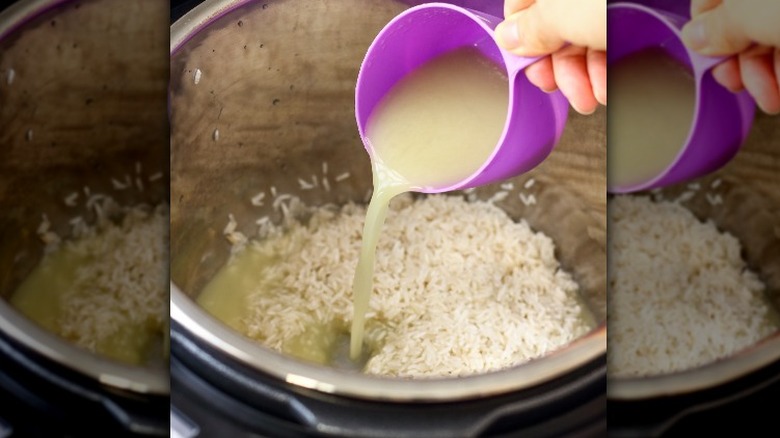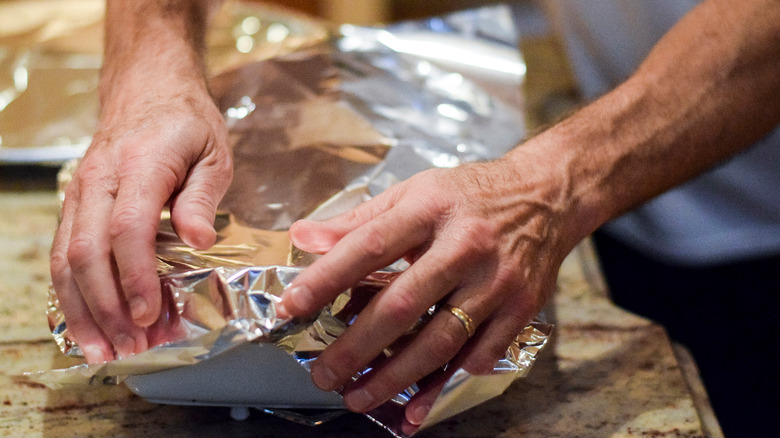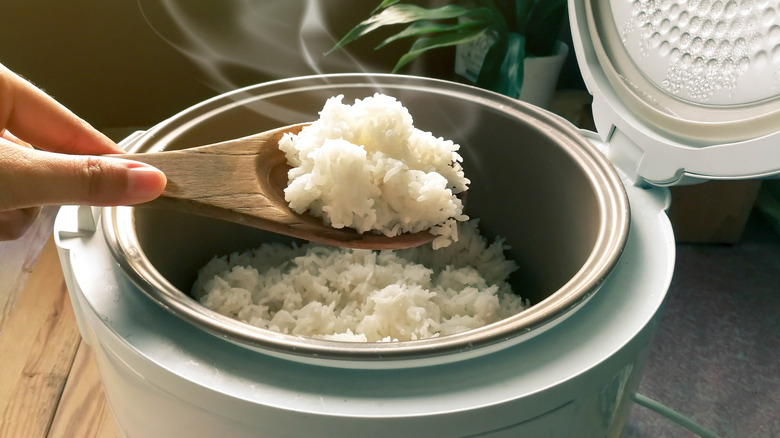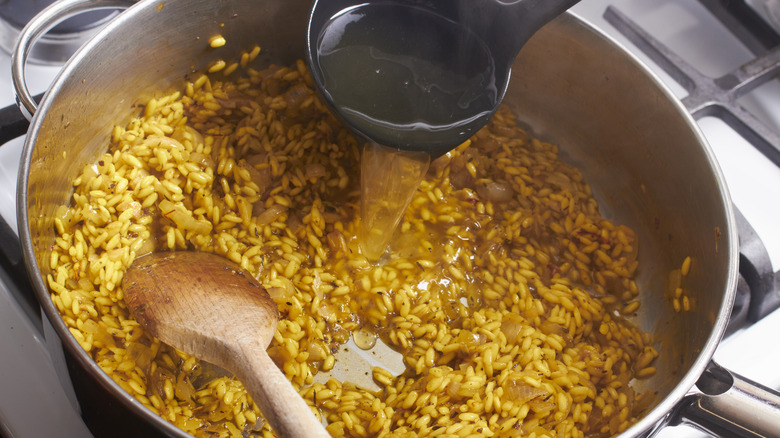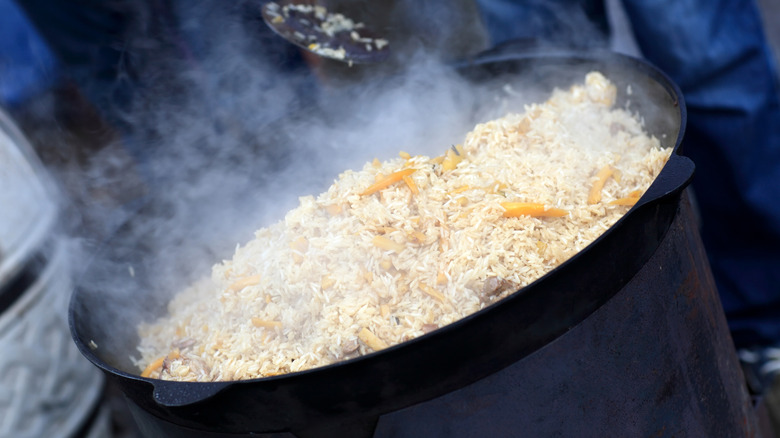Every Way To Cook Rice, Ranked Worst To Best
Rice: It's a humble staple food. Cooked in plain water, it becomes a blank culinary canvas on which home cooks can create dishes from just about every culture in the world. With a little finesse, rice turns from boring and bland into a spectacular comfort food that will steal the show away from any entrée on your table.
However, while a great rice dish is something just about everyone could appreciate, cooking that rice dish is easier said than done. Cook your rice the wrong way and you could end up with a sticky, globby, gluey mess. (In fact, according to Food & Wine, rice can be so sticky under the right circumstances that it was actually used as a glue-like substance while building the Great Wall of China.) On the flip side, you could end up with hard, crunchy rice that never seems to cook, no matter how long you leave it simmering on the stove. And if the rice ends up burnt, stuck onto the bottom of your pan, you'll have a long night of cleaning and scrubbing and scraping ahead of you.
Want to make your next rice-cooking experience a little bit easier? Cook your rice the right way. We've ranked 12 popular ways to cook rice from worst to best to help you choose the method that's right for you.
The microwave
You can really cook just about anything in the microwave, with the right steps. However, cooking rice in the microwave is particularly tricky. Think about it: How many times have you reheated leftovers in the microwave, only to find they're scorching hot on the outside and ice-cold in the middle? How many times have you popped some popcorn, on the dedicated "popcorn" setting no less, only to find the microwave's timing either doesn't quite pop all those kernels or burns the bag to a crisp?
Microwaves are finicky contraptions, so they just don't work well when you combine them with a food as finicky as rice. More times than not, if you don't have the perfect formula of timing, heat, and cooking vessel, your rice-cooking experiments will end in a microwave coated in starchy rice water and goo. This is a method that should only be used if you literally have no other option.
Want to give it a try regardless? Christian Science Monitor recommends combining a cup of rinsed, long-grain jasmine rice with a cup and a half of water in a tall, microwave-safe container. Cook it covered on low for 20 minutes, stirring every five minutes, then let it sit for another five minutes before fluffing and serving.
The puffing method
Puffed rice really only ranks higher than microwaved rice because it doesn't create the same extreme amount of mess that microwaved rice does. While the microwaved rice can at least be used in a variety of ways and cuisines, the puffing method results in a rice dish that's a little less versatile.
According to the Mahatma rice brand, puffing rice requires you to cook the rice according to package directions first and then bake on a parchment-lined baking sheet for up to 2.5 hours at 250 degrees Fahrenheit, until all the moisture is gone. Then, you have to fry the rice in 425-degree oil. The whole process requires a lot of time and the resulting product is one that could be achieved by simply purchasing a box of Rice Krispies. Don't waste your time. Instead, look to more creative ways you can use your store-bought puffed rice versus only in your cereal or in Rice Krispie treats. Puffed rice makes a crunchy topping for baked macaroni and cheese and stir fry, for example.
The rice porridge method
The rice porridge (or congee) method also ranks at the bottom of the pack, simply because it's not really that versatile compared to some of our other, higher-ranking rice-cooking methods. A staple in Asian cuisines, rice porridge takes very little time to make (about a half an hour) and only requires rice, water or stock, and salt. Once it's cooked, you can add all kinds of toppings, from eggs to shredded chicken, tofu to veggies — anything savory works.
However, while the rice porridge is pretty versatile when it comes to toppings, you're really stuck with that porridge texture that's going to get gluier and thicker over time. Additionally, the wrong water-rice ratio can leave you with a congee that's either incredibly thick or incredibly runny. For thicker porridge, What to Cook Today recommends a rice to liquid ratio of 1:7. For runnier porridge, the blog recommends a rice to liquid ratio of 1:10.
Frying
Who doesn't love fried rice? You can add in all sorts of savory deliciousness, just like you would when cooking congee. However, the one downside to frying rice is that it requires a lot of effort. You need to learn how to properly steam your rice before you fry it and then you have to worry about getting the actual frying part down. You can make things easier by using leftover takeout white rice, but you don't always have that on hand when a fried rice craving hits, which means you'd have to cook the steamed rice and then let it refrigerate overnight before frying it (and at that point, you could just order the fried rice from the Chinese restaurant directly and save yourself up to 24 hours).
Still, if you have the steamed rice on hand — no matter how you came about it — the frying part is relatively easy and fast, which is why fried rice ranks in the middle of our list. Our Easy Egg Fried Rice recipe only takes 7 minutes.
The slow cooker method
This is not a knock on slow cookers. Slow cookers are great, especially when you want to throw in a bunch of ingredients and walk out the door for the day, to come back to a fully-cooked meal just in time for dinner. However, if you're only making plain rice — not a chicken and rice casserole-style dish or a soup with rice — there's no reason to use your slow cooker.
The recipe for slow cooker rice from A Clean Bake instructs home cooks to combine a cup of rinsed jasmine rice with a cup and a half of water and a pinch of salt in the slow cooker, to cook on low heat for two and a half hours. But why use this method that takes nearly five times the amount of time it would take to simply cook the plain rice on the stove? Sure, it's easy because you're just throwing everything into a slow cooker and walking away, but it's still not a foolproof method and it takes so much longer than other tried and true methods.
Stovetop steaming
Firmly in the middle of the pack is stovetop steaming. This is the classic rice cooking method that everyone knows, and the method that you probably think of first when someone mentions cooking rice. Just boil the rice in equal to double the amount of water, cover it, and see what happens. (And if you've always thought this method was simple boiling, it's technically not — but we'll get to the boiling method next.) As you've probably experienced, cooking rice via stovetop steaming is incredibly easy to mess up and is a disaster waiting to happen if you make one wrong move.
However, if you're able to really nail this method, you'll be rewarded with gorgeous, fluffy, delicious rice that you can use just about anywhere or however you like. It's mastering the process that's the problem. To increase your luck, try the stovetop steaming tip that Christian Science Monitor suggests. The publication notes your ratio of rice to water should vary according to how old and dry your rice is, but, typically, for your average bag of pantry rice, you're safe to use one cup rice with a cup and a fourth of water.
Stovetop boiling
Stovetop boiling, on the other hand, is much easier than stovetop steaming, because you don't need to worry about rice-water ratios at all. It's more similar to how you might cook a box of pasta. Again, the Christian Science Monitor details this method and basically says you just need to add your rice and water to your favorite pot, bring it to a boil, turn down to a simmer, and keep it going until the rice is cooked. The rice only takes about 20 to 30 minutes to cook and there's no measuring.
The boiled rice is a bit fluffier than steamed rice and you get all that blank canvas versatility that you enjoy from classic steamed rice, only without all the measuring and worries. The Kitchn suggests this method works best with brown rice, which just naturally doesn't do as well as white rice with the steaming method.
The Instant Pot method
Instant Pots became all the rage several years ago and for good reason. They can do a little bit of it all, from sautéing to slow cooking, pressure cooking to rice cooking. The Instant Pot is wonderfully quick and can cook even hunks of protein from frozen in under an hour, so it's a given that your Instant Pot will be able to cook rice faster than just about anything else on this list. In fact, our Easy Instant Pot Rice recipe allows for a faster, easier cook, with little clean up.
All you have to do is add equal parts rinsed rice and water to your Instant Pot, close the lid, set it to seal, hit the "Rice" button (cook time should be around 4 minutes), and then allow for Natural Release. From there, you just need to fluff, season, and serve. This method is so simple and quick, it easily makes it into our top five ways to cook rice.
The baking method
The baking method sounds like it won't work the first time you try it, but once you do try it, you realize it's so, so easy. All you do, as the Spend with Pennies food blog explains, is preheat your oven to 375 degrees Fahrenheit; add a cup of white rice, one and three-fourths cup of boiling water, two tablespoons of butter, and a teaspoon of salt to a two-quart baking dish; stir; cover tightly with aluminum foil; and then bake until the water is gone, so about half an hour. Then, let the rice rest before fluffing and serving.
The key to making this method work is threefold. It really only works well with white rice; brown rice just seems to take longer to cook and it requires more water. Then, you have to use boiling water; the instant heat is crucial. Lastly, you have to make sure that aluminum foil is on tight — don't let the steam escape!
But, for all this, the baking method works really well. The only reason it's not ranked higher in our list is because it can't quite be adapted for brown rice.
The rice cooker method
The rice cooker method takes the stovetop method for cooking rice and makes it as easy as humanly possible. Even the worst home cooks can usually successfully use a rice cooker. Most rice cookers tell you to add rice and water at 1:1 ratio. From there, just close the lid and let the cooker do its work. Many rice cookers even turn off automatically once the rice is cooked, leaving you with one less thing to worry about.
According to The Kitchn, the only ways you could really mess up your rice when using this method is if you skip rinsing your rice before cooking and if you don't allow the rice to sit for about 10 minutes with the lid on, before opening the cooker. Both of these details keep your rice fluffy, without any gross clumps. On top of all this, the rice cooker method produces similar results to what you'll get with the Instant Pot method, only at a more affordable price point.
The risotto method
The problem with most of the above rice-cooking methods? They all leave you with a blank slate. While that's perfect for the adventurous home cook who's fine with mixing and matching flavors to see what they can come up with, that's not always ideal for everyone. So, for those who want an easy rice dish that's also impressive and flavorful without any extra work or thinking on their part, the risotto method delivers — and the good news is, while it does take a little more babysitting than some of the other methods on the list, the work is kept primarily to stirring, resulting in an amazing dish for comparatively little effort.
Something New for Dinner details the exact measurements and equipment you'll need for the risotto method, but basically you'll just want to cook some onions and garlic in olive oil, add your rice and stir until fragrant, then start adding your liquid, a ladleful at a time. Typically you want to use broth for this, for more flavor. You stir as you add the liquid, until the liquid is absorbed by the rice, then you add more liquid, until the rice is finally done. At that point, you can add in other yummy ingredients, like cheese.
The pilaf technique
We understand that risotto isn't for everyone, especially if you're not a fan of standing over a stove for 30 minutes, watching and waiting. So, for those folks who still want an impressive and immediately flavorful rice dish, the pilaf technique works wonders. It takes little skill and equipment (and ingredients) compared to the risotto method.
The Kitchn says you should only use basmati or jasmine rice for this technique. Rinse the rice, boil your water, toast your rice in butter for a few minutes, and then add the rice to your boiling water, cover, and cook until all the water is absorbed. Take it off the heat and let it sit for about 10 minutes, fluff, and serve. Thanks to the butter and toasting, the rice is flavorful all on its own, but it also is mild enough that you can add in stronger flavors for an even bigger punch.
The pilaf technique takes the top spot on our list thanks to the way it combines simplicity and flavor into one perfect package.
